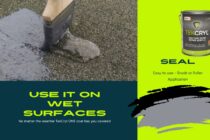Quick Solutions for Flat Roof Leaks
How to temporarily fix a leak on a flat roof?
Discover effective temporary solutions to manage leaks on flat roofs, ensuring your property stays protected until professional repairs can be made.
Step-by-Step Temporary Leak Fix
Follow these steps to quickly address a leak on your flat roof, minimizing damage and safeguarding your home.
1
Identify the Leak Source
Inspect the roof surface to locate the exact point of water entry. Check for visible cracks, punctures, or pooling water.
2
Gather Necessary Materials
Collect essential materials such as roofing tape, tarps, and sealant to temporarily patch the leak.
3
Apply Temporary Patch
Use roofing tape or a tarp to cover the leak area, ensuring it is securely fastened to prevent further water ingress.
Innovative Roofing Solutions
GRP Roof Protection
Experience unparalleled durability and weather resistance with our GRP roofing systems, designed to withstand the harshest conditions.
Felt Roof Repair Kit
Our comprehensive felt roof repair kit ensures quick and effective fixes, safeguarding your property from leaks and damage.
Bitumen Roof Reinforcement
Enhance the longevity of your bitumen roof with our advanced reinforcement solutions, tailored for maximum protection.
Choose Your Ideal Roofing Repair Solution
GRP Roofing System
Our GRP roof restoration system offers unmatched durability and resistance to harsh weather conditions, ensuring long-lasting protection for your property.
- Weather Resistance 95%
- Ease of Installation 40%
- Cost Efficiency 65%
- Maintenance Requirements 80%
- Aesthetic Appeal 85%
Felt Roof Repair Kit
The Felt Roof Repair Kit provides a quick and effective solution for patching leaks, safeguarding your home from water damage.
- Weather Resistance 95%
- Ease of Installation 40%
- Cost Efficiency 65%
- Maintenance Requirements 80%
- Aesthetic Appeal 85%
Bitumen Roof Reinforcement
Enhance the longevity of your bitumen roof with our advanced reinforcement solutions, tailored for maximum protection.
- Weather Resistance 95%
- Ease of Installation 40%
- Cost Efficiency 65%
- Maintenance Requirements 80%
- Aesthetic Appeal 85%
Understanding Roof Maintenance
Regular roof maintenance is crucial to prolong the lifespan of your roofing system and prevent costly repairs. By scheduling routine inspections, you can identify minor issues before they escalate into significant problems.
Common Roofing Problems
Roofs can suffer from a variety of issues including leaks, damaged shingles, and poor insulation. Addressing these problems promptly can save you from more extensive damage and ensure your home remains protected.
Benefits of Professional Roof Inspections
Hiring a professional to inspect your roof offers peace of mind and expert insights. Professionals can spot potential issues that might be overlooked by the untrained eye, ensuring your roof is in optimal condition.
Expert Tips for Safe and Effective Roof Repairs
When planning roof repairs, always prioritise safety by choosing a day with calm weather conditions. Ensure you have the right protective gear, including long trousers, closed-toe shoes, and a long-sleeved shirt, to safeguard against potential hazards.
For extensive repairs, renting a scaffold can provide safe access to higher areas. Avoid working on the roof during icy or snowy conditions to prevent accidents. If you’re unsure about your ability to complete the repairs safely, it’s wise to hire a professional roofing contractor.
Flat Roof Leak FAQs
Discover answers to common questions about managing flat roof leaks and temporary fixes.
How can I temporarily fix a leak on my flat roof?
To temporarily fix a leak, clean the area and apply a waterproof sealant or roofing tape to the affected spot.
What materials do I need for a temporary roof leak fix?
You will need roofing tape or sealant, a brush for cleaning, and a ladder for safe access.
Can I use tar to stop a roof leak temporarily?
Yes, roofing tar can be used as a temporary solution, but ensure it’s applied during dry weather for best results.
How long will a temporary fix last?
A temporary fix can last a few weeks to several months, depending on weather conditions and the extent of the damage.
Is it safe to fix a roof leak myself?
While minor repairs can be done safely with proper precautions, it’s advisable to consult a professional for significant leaks.
What should I do if my roof is leaking during a storm?
Place a bucket under the leak to catch water and use a tarp to cover the area until the storm passes.
How can I prevent future leaks on my flat roof?
Regular maintenance and inspections can help identify potential issues before they become serious leaks.
Should I call a professional after a temporary fix?
Yes, a professional should assess the damage to ensure a permanent solution is implemented.
What are common causes of flat roof leaks?
Common causes include poor drainage, damaged membranes, and weather-related wear and tear.
What Our Customers Say
★★★★★
The tips from the blog were a lifesaver! I managed to stop the leak until the professionals arrived. Highly recommend!
Emma J.
★★★★★
Thanks to the advice, I was able to patch my roof quickly. The service team was prompt and efficient when I called them.
Michael T.
★★★★★
Great guidance on temporary fixes! It gave me peace of mind until the repair was completed. Excellent service!
Sophia L.
Get Professional Roof Repair Today
Don’t let a small leak become a big problem. Contact us now to find the perfect solution.




